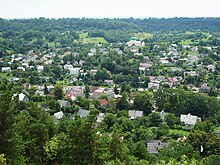Kremenets
| Kremenets | ||
| Кременець | ||

|
|
|
| Basic data | ||
|---|---|---|
| Oblast : | Ternopil Oblast | |
| Rajon : | District-free city | |
| Height : | 290 m | |
| Area : | 20.76 km² | |
| Residents : | 21,880 (2004) | |
| Population density : | 1,054 inhabitants per km² | |
| Postcodes : | 47009 | |
| Area code : | +380 3546 | |
| Geographic location : | 50 ° 6 ' N , 25 ° 44' E | |
| KOATUU : | 6123410100 | |
| Administrative structure : | 1 city | |
| Mayor : | Leonid Kitschatyj | |
| Address: | вул. Шевченка 67 47000 м. Кременець |
|
| Statistical information | ||
|
|
||
Kremenez ( Ukrainian Кременець ; Polish Krzemieniec , Russian Кременец ) is a city in western Ukraine in Ternopil Oblast north of the Oblast capital. The Kremenezer Bergland extends to the west and east of the village .
history
Kremenez was founded in the second half of the 12th century in the Principality of Halitsch at the latest and was first mentioned in writing in 1227 in the Galician-Volhyn Chronicle . Later the city was part of the Principality of Halitsch-Volhynien until 1340 . Above the town on the Bona hill are the ruins of the medieval fortress .
During the Mongol invasion of the Rus , the army of Batu Khan failed to capture the fortress at the beginning of 1241. In 1254, the fortress survived a siege by the Tatar Prince Kuremsa (Tatar: Kyremsha). In 1259 or 1261 the fortress was razed. Between 1382 and 1569 the city was in the Grand Duchy of Lithuania and between 1569 and 1795 in the Volyn Voivodeship , an administrative unit of the aristocratic republic of Poland-Lithuania . From 1795 to 1914 the city was part of the Russian Empire located volhynian governorate .
After the collapse of the Russian Empire during the First World War in 1918, the city became part of the Ukrainian People's Republic (UVR) . From 1921 to 1939 the village belonged to the Volyn Voivodeship in the Second Polish Republic . After the start of World War II in 1939, Kremenez came to the Soviet Union , as agreed in the German-Soviet non-aggression pact , and became part of the Ukrainian Soviet Socialist Republic . After the German invasion of the Soviet Union , the city was captured by German troops on July 1, 1941. In the period that followed, almost the entire Jewish population was murdered.
The Great Synagogue , built in the first half of the 19th century, was infected by the German occupiers in 1941 and later completely demolished. There is now a public park at this point. Of the 18 prayer houses and synagogues in the interwar period , only the synagogue building in the Dubensk suburb remains in Kremenez, which is used as a bus station after renovations.
After the war, the place came back to the Ukrainian Soviet Socialist Republic and has been part of the independent Ukraine since 1991.
From 1809 the Austrian botanist Wilibald Swibert Joseph Gottlieb von Besser was director of the Botanical Garden in Kremenez. He died in Kremenets in 1842.
The Kremenez ski jumping facility , which was built in 1965 and consists of several small and medium-sized hills , is also located in Kremenez .
The city was under district administration until May 13, 2015 and from that day was placed under oblast administration (district-free).
sons and daughters of the town
- Hugo Kołłątaj (1750–1812), Polish nobleman , politician, publicist, Catholic presbyter and canon , satirist, writer, geographer and historian as well as rector of the Cracow Academy (1783–1786) and legal trainee of the Grand Duchy of Lithuania (from 1786)
- Juliusz Słowacki (1809–1849) is considered to be one of the Three Bards , the national poet of Poland , one of the most important representatives of Polish Romanticism and the father of modern Polish drama
- Stepan Solskyj (1835–1900), Ukrainian theologian and mayor of Kiev from 1887 to 1900
- Tsevi Pryłucki (1862–1942), Polish newspaper editor and journalist
- Oleksandr Ossezkyj (1873–1937), Ukrainian general and defense minister
- Morris S. Kharasch (1895-1957), American chemist
- Mychajlo Werykiwskyj (1896–1962), Ukrainian composer
- Mark Kac (1914–1984), Polish-American mathematician
- Isaac Stern (1920–2001), American violinist of Ukrainian-Jewish descent
- Kazimierz Urbanik (1930–2005), Polish mathematician
- Victor Morozov (* 1950), Ukrainian songwriter, poet and translator
- Vitaly Schumbarez (* 1983), Ukrainian ski jumper
- Volodymyr Tratschuk (* 1985), former Ukrainian skiers who in the Nordic combined and ski jumping was active
- Wiktor Passitschnyk (* 1992), Nordic combined athlete
Web links
- Krzemieniec . In: Filip Sulimierski, Władysław Walewski (eds.): Słownik geograficzny Królestwa Polskiego i innych krajów słowiańskich . tape 4 : Kęs – Kutno . Walewskiego, Warsaw 1883, p. 776 (Polish, edu.pl ).
- Russian map of the city and the surrounding area
Individual evidence
- ↑ Sergey R. Kravtsov, Vladimir Levin. Synagogues in Ukraine VOLHYNIA Vol. 1. Page 339. The Center Of Jewish Art. ISBN 978-965-227-342-0 . To the synagogue
- ↑ Верховна Рада України; Постанова від 13.05.2015 № 397-VIII Про віднесення міста Кременець Кременецького району Тернопільського району Тернопільської ангопільської ангаср




